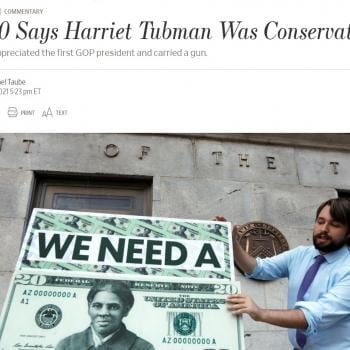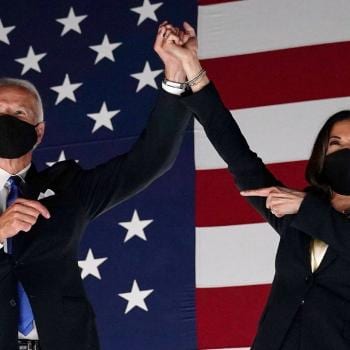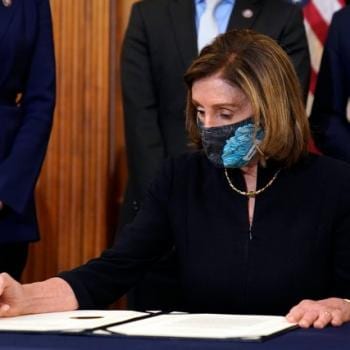I grew up in a Republican family. It was the party of Lincoln, my parents told me. They didn’t mention that it was also the party of Strom Thurmond and Jesse Helms. When I took U.S. history courses in college, I was fascinated by trying to untangle exactly what happened. When did African American voters switch from the Republican Party to the Democratic Party, and why? When—and why—did white voters in the South make the opposite journey?
In looking up something completely different yesterday, I learned that there is still an operating segregationist academy supported by the Council of Conservative Citizens, a white supremacist group. It is named Carroll Academy and is located in Carroll County, Mississippi. Curious, I googled Carroll County and stumbled upon a record of the county’s presidential election results from 1912 to to 2016. I’m not sure I’ve ever seen changing political allegiances in the South illustrated better than they are here.
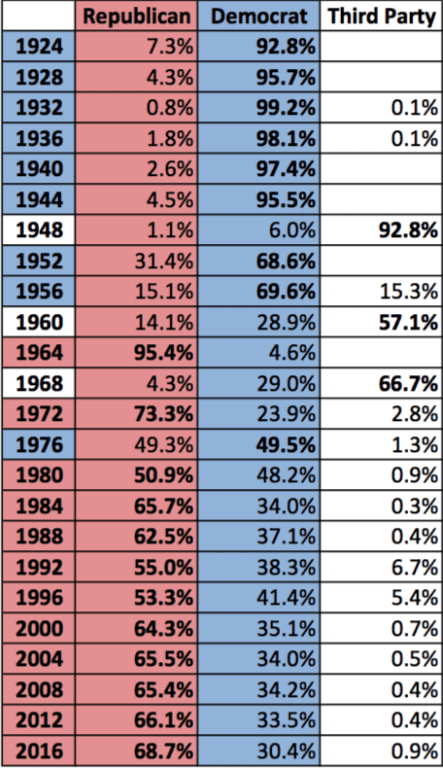
Let’s take this from the top, shall we?
During the 1850s, the Whig Party fell apart over slavery. The Republican Party, founded in 1854, quickly took its place. The Republican Party was the party of “free soil,” and the South quickly became solidly Democrat. During Reconstruction, freed blacks voted overwhelmingly Republican. Southern whites resisted Reconstruction and began a sustained (and successful) campaign to end the black vote.
After this, the South remained a Democratic bastion for nearly a century.
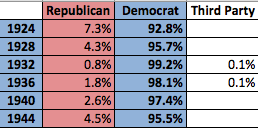
Remember, during this period African Americans were largely disenfranchised in Mississippi, so Carrol County’s voting population would likely have been entirely white—and voting in high margins for the Democratic Party.
Something curious happened in 1948:
![]()
That’s right, in 1948 the county went 92.8% for a third party—the Dixiecrats.
In some sense, the white population of Carroll County’s first allegiance was to white supremacy, not the Democratic Party. When Harry Truman desegregated the military and began making other moves in support of civil rights, southern whites bolted. They formed their own political party, the Dixiecrats, and voted for Strom Thurmond (you remember him—he later became a Republican).
What happened in the 1950s? Let’s have a look.

The elections of 1952 and 1956 pitted Dwight D. Eisenhower against Adlai Stevenson. In 1952, nearly one-third of voters in Carroll County pulled the lever for Eisenhower, the highest percentage a Republican candidate received there since Reconstruction. This was likely due in part Eisenhower’s status as a popular WWII general who transcended political party (interestingly, he was listed as an independent on the Mississippi ballot). In 1956, the Eisenhower vote was halved; the remainder went to an unpleged slate of electors put forward by the white supremacist Citizens’ Council.
What happened next? Good question.
![]()
If you just asked yourself “What the blazes happened here?” you’re not alone. Lots of things happened, but, in sum, the majority of voters in Carroll County decided to vote for the Citizens’ Council’s unpledged slate of electors. Democratic candidate John F. Kennedy’s Catholic faith may have played some role; most white Mississippians were Protestant, and often rabidly anti-Catholic. Whatever the reason, in the 1960 presidential election, the Carroll County vote went to the white supremacist electors.
The next election, things got even weirder.
![]()
Is your jaw on the floor? If it isn’t, it should be.
How did a Deep South state that hadn’t gone Republican since Reconstruction suddenly, with no warning, vote over 95% Republican? What witchcraft is this?! Well. It wasn’t witchcraft, and it wasn’t a polling malfunction. It was Barry Goldwater. And—to be fair—it was also Lyndon B. Johnson’s Civil Rights Act of 1964.
President Lyndon B. Johnson, a Democrat, signed the Civil Rights Act of 1954 on July 2 of that year. Barry Goldwater, soon to be nominated the Republican Party’s presidential candidate, voted against this bill, arguing that federal protections for civil rights undermined states’ sovereignty. Southern whites approved, and voted en masse for Goldwater. For the first time since Reconstruction, a Republican won the South—and, and a terrible irony that would have had Lincoln spinning in his grave, he did so by opposing federal protections for civil rights.
Are you noticing a theme? If white southern voters stopped voting for Democratic presidential candidates because those candidates started supporting the civil rights movement—and started voting for Republican presidential candidates because these candidates stopped supporting protections for civil rights—perhaps white southerners didn’t change parties. Perhaps it was the parties that changed.
Hold on, though, because we’re not done with third parties.
![]()
In 1968, white supremacist George Wallace ran as an independent. Once again, the white voters of Carroll County hopped on board, throwing the county to a white supremacist candidate or electoral slate for the third time since WWII (first in 1948, then in 1960, and now in 1968). The switch from Democrat to Republican, in other words, came through a bumpy process dotted with independent white supremacist candidates.
Why didn’t Wallace get 95% of the vote, as Thrumond did in 1948 and Goldwater in 1964? That would be the result of a pesky little thing called the Voting Rights Act of 1965. The number of voters in Carroll County jumped from 2,141 in 1964 to 3,194 in 1968 without any substantive increase in population. The increase was in franchise, not in people. Did those new African American voters vote Republican? No. No they did not.
It is quite possible that the entire Democratic vote in Carroll County in 1968 was comprised of newly enfranchised African Americans. The number of individuals who voted for Wallace—2,131—was essentially identical to the total number of votes (all white) cast in Carroll County in the previous presidential election; in theory, all of the white voters in the county may have cast their ballots for Wallace.
And remember—in 1968, the Democratic Party ran Hubert Humphrey, the lead author of the Civil Rights Act of 1964. Back in 1948, the year Carroll County voters bolted to the Dixiecrats, Humphrey managed to insert an anti-segregation pledge into the Democratic Party Platform and gave a speech at the National Democratic Convention calling on Democrats to “to get out of the shadow of states’ rights and to walk forthrightly into the bright sunshine of human rights.” He wasn’t exactly the kind of guy who appealed to white southern voters.
In 1972, for the second time in eight years, the Carroll County vote went Republican.
![]()
While the percentage of Carroll County voters going Democrat decreased slightly from 29% to 24%, the total number of votes cast decreased as well, down to 2,424. This may indicate a lower amount of interest in the election—Mississippi as a whole saw a decline in voter turnout—or it may indicate some form of voter suppression.
There’s something more important to note, though—far right-wing John Birch Society member John Schmitz, who ran on the same ticket George Wallace had a year before, captured a small proportion of the vote. Unlike in 1968, nearly all of the county’s white vote went instead to the Republican candidate, incumbent “law and order” president Richard Nixon, well known for his dog whistling and race baiting. Nixon’s actions between his election in 1968 and his reelection in 1972 appealed to white southerners.
White southerners initially responded to Democratic support for civil rights by fielding white supremacist candidates or slates, but as time went on this became unnecessary: voting for Republican candidates would get them the same results. Before anyone objects, let me note that by this time Strom Thurmond, the South’s 1948 white supremacist Dixiecrat Party candidate, was himself a Republican.
Still, for all this, Carroll County had one more Democratic vote left in it.
![]()
Why? While Jimmy Carter was a strong supporter of civil rights, he was also a southern evangelical who got his start as a Georgia peanut farmer.
While I don’t have a racial breakdown for Carroll County’s results, national election results would suggest that only squeaked out his bare majority in the county—beating Ford by 0.2%—by winning the overwhelming majority of the country’s black vote. Indeed, it was the black vote in the South that pushed Carter over the edge nationally.
Since 1980, Carroll County has gone to the Republican in every presidential election.
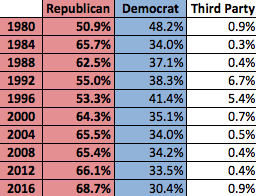
Reagan won the majority of the Carroll County vote in 1980 by only a hairsbreadth—the same was true throughout the South—but from 1984 to the present, the Republican presidential candidate has won over 60% of the vote in the county in every election save two. In 1992 and 1996, Carroll County went for the Republican candidate by a lower margin, likely reflecting the southern origins and mannerisms of Bill Clinton.
While I had trouble finding historical statistics, the population of Carroll County, Mississippi, is roughly one-third African American today. You can see that reflected in the consistent one-third of the vote the Democratic presidential candidate receives in Carroll County each year. Oh, certainly, some 10% of African Americans vote Republican, and some number of white voters are pulling the lever for Democrats. Still, the racial divide in southern party politics remains tenacious: In 2012, Barack Obama won less than 20% of the white vote in nearly every Mississippi county.
We’ve covered how southern Democrats became Republicans—what about how African American voters became Democrats?
When the doors slammed shut on southern suffrage during the Jim Crow era, only African Americans living in the North could vote. Vote they did, and almost always for Republicans. But this was not to last. In every presidential election since 1936, the majority of African American voters have cast ballots for the Democratic candidate.

There’s another way to examine this transition.
During Reconstruction, every African American elected to the U.S. House and Senate was a Republican. No African Americans were elected to Congress between 1900 and 1928, when Oscar De Priest of Chicago, Illinois, was elected for the first of three consecutive terms. In 1934, Arthur Mitchell, also African American, ran against De Priest as the Democratic candidate for the same seat, and won. For the next 32 years, every black U.S. Representative and Senator ran as a Democrat.
I have seen some conservatives suggest that African Americans only started voting for Democrats because of the New Deal—in other words, they wanted handouts. The reality wasn’t so simple. Michell defeated De Priest in part because the local mayor had begun to court black voters by appointing African Americans to positions in government. In Rising Tide, historian John Barry suggests that President Herbert Hoover, a Republican, went back on key promises to African American leaders, which played a significant role in losing Republicans the black vote. The change was multifaceted.
Even if African Americans had initially begun voting for Democratic candidates only because they wanted the government to do more to alleviate their hardship during the Great Depression, what happened next was important: Democrats began to court the black vote by making gestures of support for civil rights. In response, southern Democrats began to jump ship for independent white supremacist candidates. At some point, Republican strategists saw an opportunity and began courting southern segregationists. This in turn made black voters feel less welcome in the Republican Party.
While the Republican Party Platform of 1960 supported school desegregation, the Republican Party Platform of 1964 called for resisting “efforts which endanger local control of schools” and opposed “the abandonment of neighborhood schools, for reasons of race,” a reference to school busing and other efforts to combat the resegregation of public schools through white flight. Indeed, the platform referred to such efforts as “inverse discrimination.” The Democratic Party Platform of 1964, meanwhile, condemned the Ku Klux Klan. The parties were changing, and and that change was not mere window dressing.
In the South, participation in the Democratic Party had long been limited to white voters. In 1964, civil rights activists organized to change this, taking their complaints to the national Democratic Party leadership. In response, President Lyndon B. Johnson, a Democrat, passed the Voting Rights Act of 1965, re-enfranchizing African Americans after nearly a century. Southern politicians like Strom Thurmond and Jesse Helms, longterm segregationists, found that they were more comfortable in a Republican Party that increasingly stood for states’ rights and local control, ideas that were often code for things like ending federal oversight of school desegregation.
In some sense, what played out was a cycle that fed on itself and ended only when the two groups—African Americans and southern whites—had fully switched parties. But these groups would never have changed allegiances if the parties themselves had not changed, courting this group or that and shaped by one or the other in return.
In this way the party of Lincoln became the party of Strom Thurmond and Jesse Helms.
I have a Patreon! Please support my writing!







